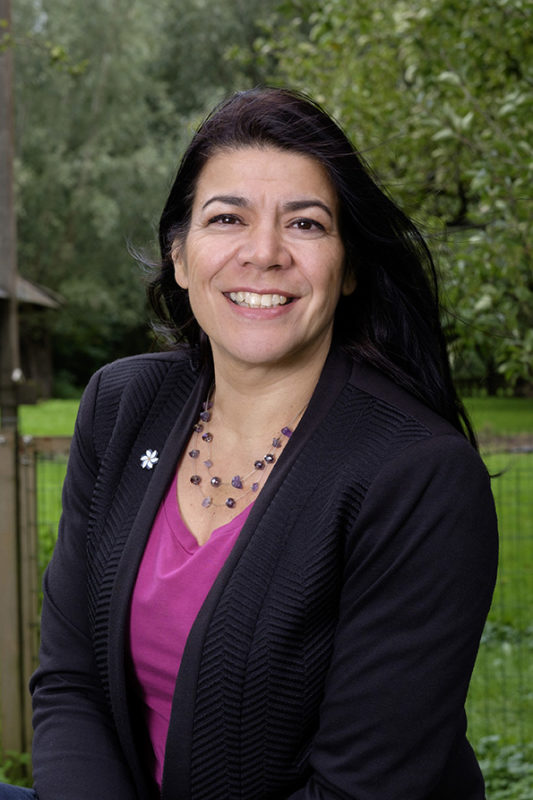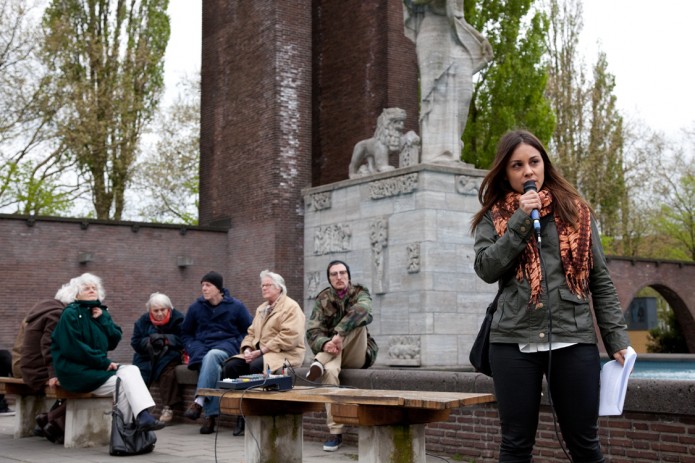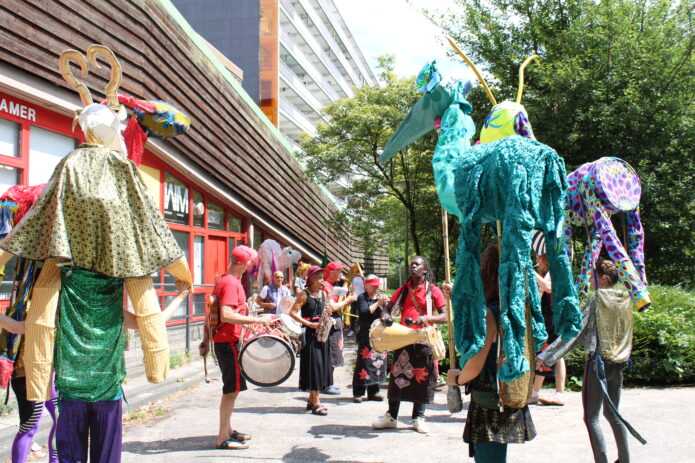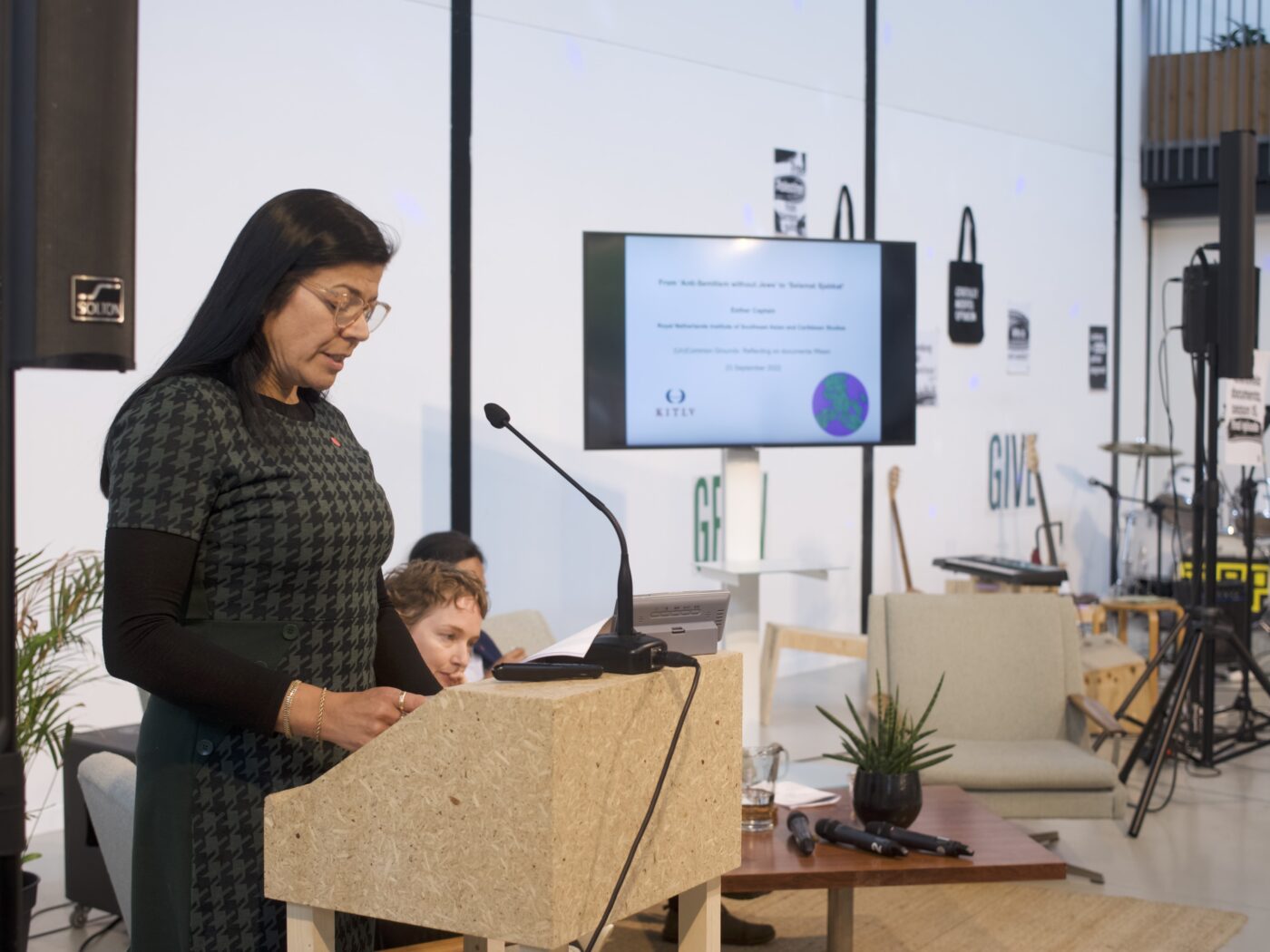 Framer Framed Symposium: (un)Common Grounds - Reflecting on documenta fifteen (2022). Photo: Ju An Hsieh
Framer Framed Symposium: (un)Common Grounds - Reflecting on documenta fifteen (2022). Photo: Ju An Hsieh Becoming ‘Established’ While Pioneering, a Note on the History of Framer Framed - by Esther Captain
What follows in this text is Esther Captain’s personal account of being engaged with Framer Framed since the organisation started as a nomadic public forum in 2009. Captain has been involved with Framed Framed on various occasions and in many capacities; as part of the audience, as a speaker and chair at several activities of the project, and during the years from 2017 to 2021 as a member of the supervisory board of Framer Framed. This reflection on how Framer Framed has mediated and nurtured social change is based on her own notes and memories as well as archival material of board meetings and the unsurpassed (online) archive of the organisation. Marking the fifteenth anniversary of Framer Framed, Captain’s text distinguishes three meaningful moments in time and connects these to characteristics of Framer Framed that have, in her opinion, have been essential if we are to understand how the platform has navigated and developed through time within the Dutch cultural landscape.
Text by Esther Captain
2009: Questioning Disciplines
In 2009, my first encounter with Framer Framed was at a public meeting titled Onbegrensd verzamelen, addressing the necessity to free the Dutch museum world of the historical and colonial divide between so-called ‘Western’ and ‘non-Western’ art. This distinction had resulted in an unproductive distribution in which ‘Western’ art objects were collected in museums of modern art and ‘non-Western’ art objects in ethnographic museums. This particular insight had a special appeal to me.
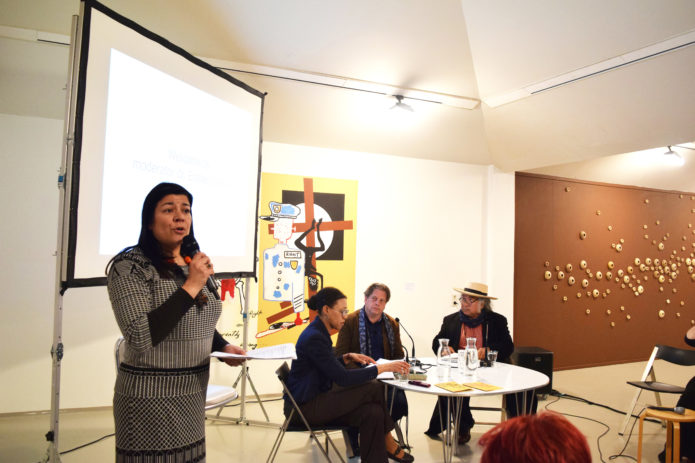
Introduction by moderator Esther Captain at the Symposium: In the future everything remains uncertain: A discussion on art
In 2002, I defended my PhD at Utrecht University. During the writing of my dissertation, when I felt the need to take a break and get out of my office, I went to the Aboriginal Art Museum (AAMU) in Utrecht, located practically next door. Being surrounded by the art of colourful dots, figures and landscapes had a calming effect on my brains and I appreciated the modernity of the work that was shown there. Framer Framed and AAMU have collaborated on several projects over the years, rethinking curatorial and institutional practices. Unfortunately, AAMU had to close its doors in 2017, one of the last in a string of museums positioned as ethnic/ethnographic/postcolonial institutions¹. While AAMU was a private museum, the others were closed because the Dutch neoliberal government withdrew their financial support, backed by populist anti-migrant tendencies. The debate that Framed Framed had already initiated in 2009 pointed ahead to what had become a harsh reality in which the disciplinary division between modern art museums on the one hand and ethnographic museums on the other hand resulted in dismantlement of the latter institutions, liquidating their infrastructure, the institutional and people’s expertise and their networks. Questioning disciplines might be viewed by some as a theoretical exercise, but disciplines can have unfair ramifications and halt social change – which is why Framer Framed rightfully keeps on exploring this dimension through cultural practices.
2012: Locally Based Projects to Address Sensitive Topics with a Global Impact
Recently, important research projects have been conducted to address the history of slavery and colonialism and its legacy in the cities of Rotterdam, Amsterdam and Utrecht. This resulted not only in book publications that reached a broad audience, but also in the offering of apologies by their respective mayors for the involvement of the past city councils in colonial exploitation. Research projects on (amongst others) Den Haag, Haarlem, Leiden and Tilburg are being done at the time of writing of this text. In fact, Framer Framed anticipated this development a decade before the current interest by setting the Monument Indië Nederland center stage in the 2012-program Hacking History; an open brainstorming about the relationship between the Netherlands and Indonesia and its representation in public space. It was formerly called Van Heutsz-monument, once a tribute to the deeds of General Van Heutsz in Indonesia, but controversial ever since its construction in 1935. Whereas previously, it has been easy to dismiss slavery and colonialism as a faraway incident, Hacking History has pointed out that there is a strong connection between the here and now, the past of slavery and colonialism in the present: its traces and ramifications can be found just outside your doorstep, in tangible and intangible forms. Bypassing the local-global, West-East and North-South division by exploring how locally based projects are interconnected with global issues, Framer Framed has been innovative in addressing sensitive topics that go beyond (inter-)national borders. This approach has been embraced by the city-specific studies and more of these will surely follow, raising awareness and the great potential of involving those for whom previously the history of slavery and colonialism has been a distant past.
2018: Reaching Out
At the beginning of 2018, I had the pleasure to chair a self-reflexive meeting among Framed Framed colleagues in order to discuss its own practices as an art platform that was undergoing a sudden and, in some ways, unexpected development in becoming more institutionalised. This went hand in hand with the wish and need to professionalise, while at the same time reconfirming its ambition to do justice to the complexity of today’s society and ecology. Being a member of the advisory board at that time, I had enough inside knowledge about the organisation’s basic principles and mission. I was nevertheless positively surprised by the candid way co-workers, varying from staff members, directors, freelancers and interns, talked about the dynamics in the office. Reaffirming the starting point that Framed Framed’s ambition is to operate as an open and democratic organisation as much as possible, the success of ground-breaking programming as well as in securing long term funding had literally led to growing pains. On the one hand, the need was expressed to create a more solid structure of the organisation on the one hand (with amenities such as a realistic salary and permanent positions for staff), and on the other hand the wish to keep its flexibility, enabling to quickly engage with actuality in its program, such as creating solidarity with the Black Lives Movement (and, later, with Ukraine) or reassessing Framer Framed activities in order to deal with Covid-19 pandemic. Framer Framed thus is changing its ad hoc way of functioning into project-based working, creating intersectional approach to the platform’s policy in general and its Human Resources policy in particular. The latter is based on scouting for new talent and creating opportunities, supporting colleagues in need (some of which are refugees, possess no papers or struggling with their health) and continuing to be self-reflexive. In addition to caring for itself as a professionalizing organisation, the question of how to reach out beyond its usual audience had priority and reflected that of many other museums and art galleries. For a long time, the public engaging with cultural activities in the Netherlands were people aged between 25-45 years old, and who consider themselves as part of the intellectual urban elite. Whereas communities with different cultural heritage, educational and linguistic background were less easily reached. This was tackled in 2018 by the creation of Werkplaats Molenwijk, a typical working-class neighbourhood in the North of Amsterdam. Werkplaats Molenwijk has its own programming and activities and also offers space for artist residencies, where artists temporarily reside in the neighbourhood and create new work in dialogue with the community. Once more, the local acts as a starting point here to address global issues.
By Way of Conclusion
Framer Framed started in 2009 as a nomadic public forum in Utrecht, hometown of the influential nomadic thinker, philosopher and source of inspiration Rosi Braidotti. Framer Framed’s nomadic lifestyle and way of operating were born out of necessity and can be placed in the emergence of other pop-up exhibition spaces and venues at that time. Without a permanent location and without structural funding, it has been a thin and a fine line on which Framer Framed has been walking throughout the years. There were times when directors and boards considered terminating the organisation. The reason was not because of lacking inspiration, but because the prospects for financing in the (very) near future seemed grim. While successful in curating striking exhibitions and developing innovative activities, Framed Framed has succeeded in acquiring projects and long-term funding later on (supported by key partners, such as the Ministry of Education, Culture and Science and the Amsterdam Fund for the Arts). The organisation has grown into a distinct voice within the museum world: an independent network for exchanging knowledge and a platform to rethink the role of art and the position of art institutions in a rapidly developing society. Several relocations were indicative of this maturing process. In 2014, an exhibition venue in the Tolhuistuin was opened, enabling the platform to shift towards organising programs and exhibitions in its own space. In 2019, the organisation moved to the premises of a former gas factory at Oranje-Vrijstaatkade in the East of Amsterdam, with larger exhibition and office spaces.
It might therefore appear that Framed Framed has become an established organisation while pioneering. However, its current position has been far from evident, nor can it be taken for granted. After all, the socio-economic and political context in which Framer Framed is situated is decisive for how its engagement and activities are considered, as earlier experiences of similar organisations discussed in this text have shown. The great achievement of Framer Framed has been that while pioneering and against all kinds of odds, it became a very respected platform. The three more organisational and process-based elements (questioning disciplines, locally based projects to address sensitive topics with a global impact and reaching out) that I have distinguished as vintage and distinctive for Framer Framed were not the only factors making it a successful endeavour. When working with Framer Framed, I was struck by the integrity, agility, stamina and courage of each person involved: individual traits on the micro level that can make all the difference in times when the macro level of socio-economic and political context may change again.
The name Framer Framed is derived from the title of a book by filmmaker, writer and literary theorist Trinh T. Minh-ha. It seems fitting to end with a quote from her work as someone who has been a source of inspiration for so many, but especially for this platform as it reflects Framer Framed’s way of working, allowing for a plethora of insights to be injected into the world of art and the academic.
“Never does one open the discussion by coming right to the heart of the matter. For the heart of the matter is always somewhere else than where it is supposed to be. To allow it to emerge, people approach it indirectly by postponing until it matures, by letting it come when it is ready to come. There is no catching, no pushing, no directing, no breaking through, no need for a linear progression which gives the comforting illusion that one knows where one goes.”²
- 1. The National Institute for the Study of Slavery and its Legacy (NiNSee) in Amsterdam and Museum Maluku (Moluccan Museum) in Utrecht were closed in 2012, the library and theatre of the Royal Tropical Institute (KIT) in Amsterdam were closed in the same year, Museum Nusantara in Delft was closed in 2013. See for an analysis of this: Esther Captain (2017), ‘The Selective Forgetting and Remodeling of the Past. Postcolonial Legacies in the Netherlands’ in: Stefan Jonsson and Julia Willén (eds.), Austere Histories in European Societies: Social Exclusion and the Contest of Colonial Memories. London: Routledge 2017, 59-73.
2. https://www.goodreads.com/author/quotes/215878.Trinh_T_Minh_ha
Art economy / Amsterdam Noord / Amsterdam Oost / Museology / New Museology / Contested Heritage /
Agenda
Collecting without boundaries. Creating a future-proof museum
A discussion on collection exchange, mobility and museum collaboration.
Hacking History
A brainstorming about the relationship between the Netherlands and Indonesia and its representation in public space.
Collecting without Borders
Ethnographic, historical and art museums in dialogue on collecting and presenting global art.
Network
